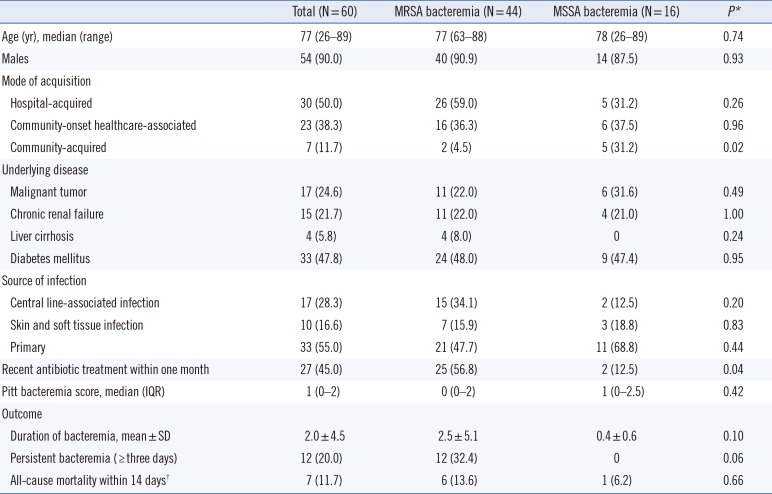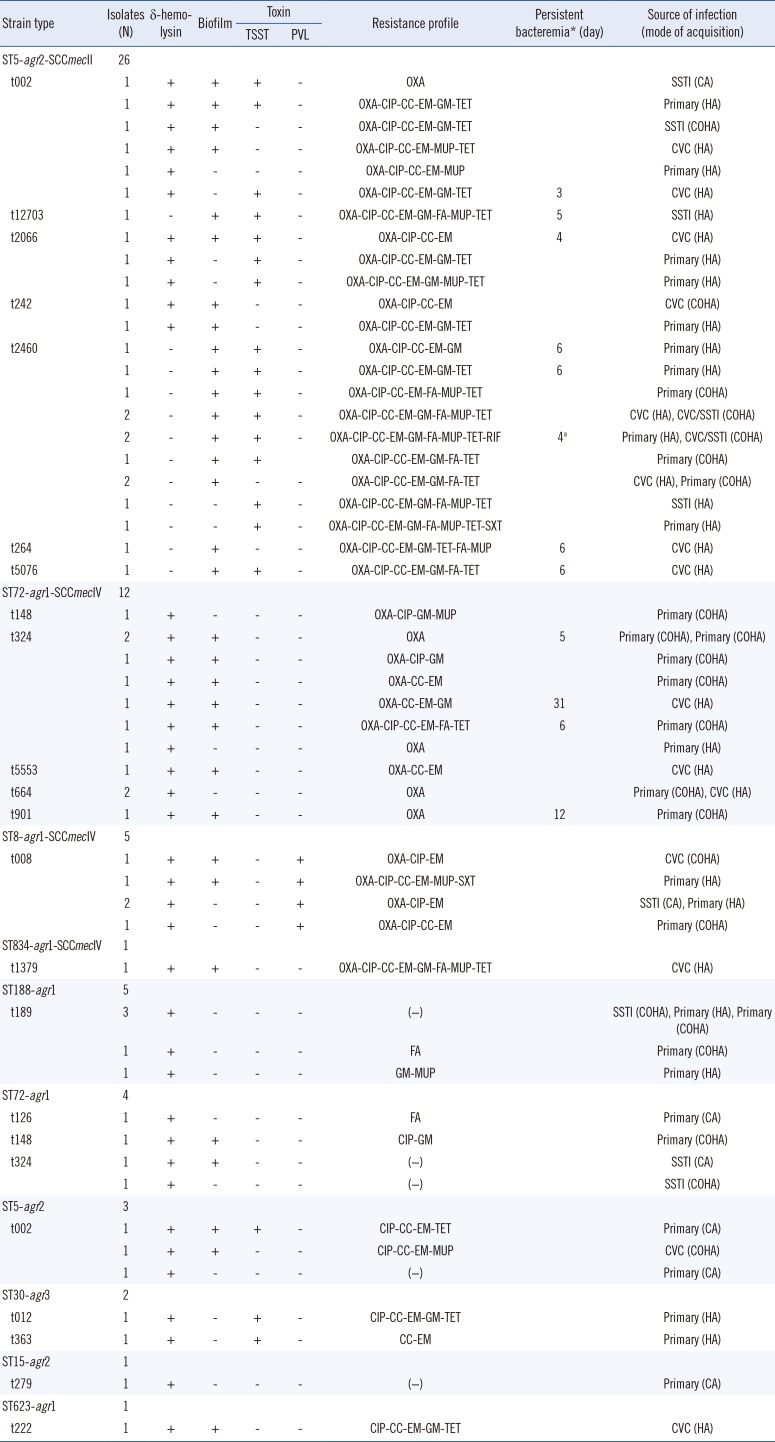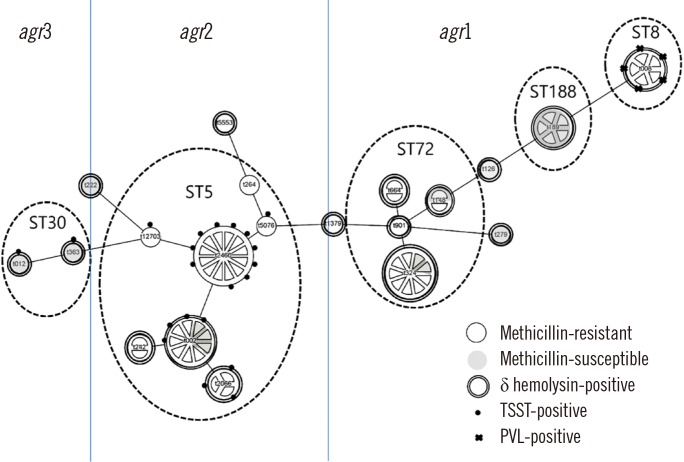1. Song JH, Hsueh PR, Chung DR, Ko KS, Kang CI, Peck KR, et al. Spread of methicillin-resistant
Staphylococcus aureus between the community and the hospitals in Asian countries: an ANSORP study. J Antimicrob Chemother. 2011; 66:1061–1069. PMID:
21393157.
2. Otter JA, French GL. Community-associated meticillin-resistant
Staphylococcus aureus strains as a cause of healthcare-associated infection. J Hosp Infect. 2011; 79:189–193. PMID:
21741111.
3. DeLeo FR, Otto M, Kreiswirth BN, Chambers HF. Community-associated methicillin-resistant
Staphylococcus aureus. Lancet. 2010; 375:1557–1568. PMID:
20206987.
4. Bal AM, Coombs GW, Holden MTG, Lindsay JA, Nimmo GR, Tattevin P, et al. Genomic insights into the emergence and spread of international clones of healthcare-, community- and livestock-associated methicillin-resistant
Staphylococcus aureus: blurring of the traditional definitions. J Glob Antimicrob Resist. 2016; 6:95–101. PMID:
27530849.
5. Kim D, Ahn JY, Lee CH, Jang SJ, Lee H, Yong D, et al. Increasing resistance to extended-spectrum cephalosporins, fluoroquinolone, and carbapenem in gram-negative bacilli and the emergence of carbapenem non-susceptibility in klebsiella pneumoniae: analysis of Korean Antimicrobial Resistance Monitoring System (KARMS) data from 2013 to 2015. Ann Lab Med. 2017; 37:231–239. PMID:
28224769.
6. Kang GS, Jung YH, Kim HS, Lee YS, Park C, Lee KJ, et al. Prevalence of major methicillin-resistant
Staphylococcus aureus clones in Korea between 2001 and 2008. Ann Lab Med. 2016; 36:536–541. PMID:
27578506.
7. Kim ES, Song JS, Lee HJ, Choe PG, Park KH, Cho JH, et al. A survey of community-associated methicillin-resistant
Staphylococcus aureus in Korea. J Antimicrob Chemother. 2007; 60:1108–1114. PMID:
17884831.
8. Chong YP, Kim ES, Park SJ, Park KH, Kim T, Kim MN, et al. Accessory gene regulator (
agr) dysfunction in
Staphylococcus aureus bloodstream isolates from South Korean patients. Antimicrob Agents Chemother. 2013; 57:1509–1512. PMID:
23254438.
9. Park C, Lee DG, Kim SW, Choi SM, Park SH, Chun HS, et al. Predominance of community-associated methicillin-resistant
Staphylococcus aureus strains carrying staphylococcal chromosome cassette mec type IVA in South Korea. J Clin Microbiol. 2007; 45:4021–4026. PMID:
17942660.
10. Park KH, Chong YP, Kim SH, Lee SO, Choi SH, Lee MS, et al. Community-associated MRSA strain ST72-SCC
mecIV causing bloodstream infections: clinical outcomes and bacterial virulence factors. J Antimicrob Chemother. 2015; 70:1185–1192. PMID:
25433004.
11. Joo EJ, Choi JY, Chung DR, Song JH, Ko KS. Characteristics of the community-genotype sequence type 72 methicillin-resistant
Staphylococcus aureus isolates that underlie their persistence in hospitals. J Microbiol. 2016; 54:445–450. PMID:
27225462.
12. Park SH, Park C, Yoo JH, Choi SM, Choi JH, Shin HH, et al. Emergence of community-associated methicillin-resistant
Staphylococcus aureus strains as a cause of healthcare-associated bloodstream infections in Korea. Infect Control Hosp Epidemiol. 2009; 30:146–155. PMID:
19128184.
13. Sung JY, Lee J, Choi EH, Lee HJ. Changes in molecular epidemiology of community-associated and health care-associated methicillin-resistant
Staphylococcus aureus in Korean children. Diagn Microbiol Infect Dis. 2012; 74:28–33. PMID:
22722011.
14. Kang CK, Cho JE, Choi YJ, Jung Y, Kim NH, Kim CJ, et al. agr dysfunction affects staphylococcal cassette chromosome mec type-dependent clinical outcomes in methicillin-resistant
Staphylococcus aureus bacteremia. Antimicrob Agents Chemother. 2015; 59:3125–3132. PMID:
25779574.
15. Caffrey AR, LaPlante KL. Changing epidemiology of methicillin-resistant
Staphylococcus aureus in the Veterans Affairs Healthcare System, 2002-2009. Infection. 2012; 40:291–297. PMID:
22161259.
16. Stenehjem E, Stafford C, Rimland D. Reduction of methicillin-resistant
Staphylococcus aureus infection among veterans in Atlanta. Infect Control Hosp Epidemiol. 2013; 34:62–68. PMID:
23221194.
17. Roth JA, Tschudin-Sutter S, Dangel M, Frei R, Battegay M, Widmer AF. Value of the Pitt Bacteraemia Score to predict short-term mortality in
Staphylococcus aureus bloodstream infection: a validation study. Swiss Med Wkly. 2017; 147:w14482. PMID:
28804865.
18. Sakoulas G, Eliopoulos GM, Moellering RC, Wennersten C, Venkataraman L, Sakoulas G, et al. Accessory gene regulator (
agr) locus in geographically diverse
Staphylococcus aureus isolates with reduced susceptibility to vancomycin. Antimicrob Agents Chemother. 2002; 46:1492–1502. PMID:
11959587.
19. Oliveira DC, de Lencastre H. Multiplex PCR strategy for rapid identification of structural types and variants of the
mec element in methicillin-resistant
Staphylococcus aureus. Antimicrob Agents Chemother. 2002; 46:2155–2161. PMID:
12069968.
20. Enright MC, Day NPJ, Davies CE, Peacock SJ, Spratt BG. Multilocus sequence typing for characterization of methicillin-resistant and methicillin-susceptible clones of
Staphylococcus aureus. J Clin Microbiol. 2000; 38:1008–1015. PMID:
10698988.
21. Jarraud S, Mougel C, Thioulouse J, Lina G, Meugnier H, Forey F, et al. Relationships between
Staphylococcus aureus genetic background, virulence factors,
agr groups (alleles), and human disease. Infect Immun. 2002; 70:631–641. PMID:
11796592.
22. Klevens RM, Morrison MA, Nadle J, Petit S, Gershman K, Ray S, et al. Invasive methicillin-resistant
Staphylococcus aureus infections in the United States. JAMA. 2007; 298:1763–1771. PMID:
17940231.
23. Mermel LA, Allon M, Bouza E, Craven DE, Flynn P, O'Grady NP, et al. Clinical practice guidelines for the diagnosis and management of intravascular catheter-related infection: 2009 Update by the Infectious Diseases Society of America. Clin Infect Dis. 2009; 49:1–45. PMID:
19489710.
25. Sohn KM, Chung DR, Baek JY, Kim SH, Joo EJ, Ha YE, et al. Post-influenza pneumonia caused by the USA300 community-associated methicillin-resistant
Staphylococcus aureus in Korea. J Korean Med Sci. 2012; 27:313–316. PMID:
22379344.
26. Lee H, Kim ES, Choi C, Seo H, Shin M, Bok JH, et al. Outbreak among healthy newborns due to a new variant of USA300-related meticillin-resistant
Staphylococcus aureus. J Hosp Infect. 2014; 87:145–151. PMID:
24856113.
27. Carrel M, Perencevich EN, David MZ. USA300 methicillin-resistant
Staphylococcus aureus, United States, 2000–2013. Emerg Infect Dis. 2015; 21:1973–1980. PMID:
26484389.
28. Peck KR, Baek JY, Song JH, Ko KS. Comparison of genotypes and enterotoxin genes between
Staphylococcus aureus isolates from blood and nasal colonizers in a Korean hospital. J Korean Med Sci. 2009; 24:585–591. PMID:
19654937.
29. Oh TS, Nam YS, Kim YJ, Yang HS, Lee MY, Gu HJ, et al. Trends in bloodstream infections at a Korean university hospital between 2008 and 2013. Ann Clin Microbiol. 2015; 18:14–19.
30. Cha HY, Moon DC, Choi CH, Oh JY, Jeong YS, Lee YC, et al. Prevalence of the ST239 clone of methicillin-resistant
Staphylococcus aureus and differences in antimicrobial susceptibilities of ST239 and ST5 clones identified in a Korean hospital. J Clin Microbiol. 2005; 43:3610–3614. PMID:
16081886.
31. Park JY, Jin JS, Kang HY, Jeong EH, Lee JC, Lee YC, et al. A comparison of adult and pediatric methicillin-resistant
Staphylococcus aureus isolates collected from patients at a university hospital in Korea. J Microbiol. 2007; 45:447–452. PMID:
17978805.
32. Mendes RE, Deshpande LM, Smyth DS, Shopsin B, Farrell DJ, Jones RN. Characterization of methicillin-resistant
Staphylococcus aureus strains recovered from a phase IV clinical trial for linezolid versus vancomycin for treatment of nosocomial pneumonia. J Clin Microbiol. 2012; 50:3694–3702. PMID:
22972817.
33. D'Agata EM, Webb GF, Horn MA, Moellering RC Jr, Ruan S. Modeling the invasion of community-acquired methicillin-resistant
Staphylococcus aureus into hospitals. Clin Infect Dis. 2009; 48:274–284. PMID:
19137654.
34. Lim S, Chung DR, Baek JY, Kim SH, Peck KR, Lee NY, et al. A third case of USA300 community-associated methicillin-resistant
Staphylococcus aureus infection in Korea. Korean J Intern Med. 2013; 28:258–260. PMID:
23524494.
35. Jung J, Song EH, Park SY, Lee SR, Park SJ, Sung H, et al. Emergence of Panton-Valentine leucocidin-positive ST8-methicillin-resistant
Staphylococcus aureus (USA300 clone) in Korea causing healthcare-associated and hospital-acquired bacteraemia. Eur J Clin Microbiol Infect Dis. 2016; 35:1323–1329. PMID:
27209287.
36. Park SH, Kim KJ, Kim BK, Hwang SM. Molecular characterization of community-associated methicillin-resistant and methicillin-susceptible Staphylococcus aureus isolates from children with skin infections in Busan, Korea. J Bacteriol Virol. 2015; 45:104–111.
37. Shore AC, Rossney AS, O'Connell B, Herra CM, Sullivan DJ, Humphreys H, et al. Detection of staphylococcal cassette chromosome
mec-associated DNA segments in multiresistant methicillin-susceptible
Staphylococcus aureus (MSSA) and identification of
Staphylococcus epidermidis ccrAB4 in both methicillin-resistant
S. aureus and MSSA. Antimicrob Agents Chemother. 2008; 52:4407–4419. PMID:
18852274.







 PDF
PDF ePub
ePub Citation
Citation Print
Print



 XML Download
XML Download